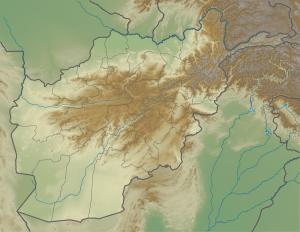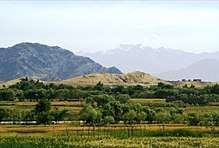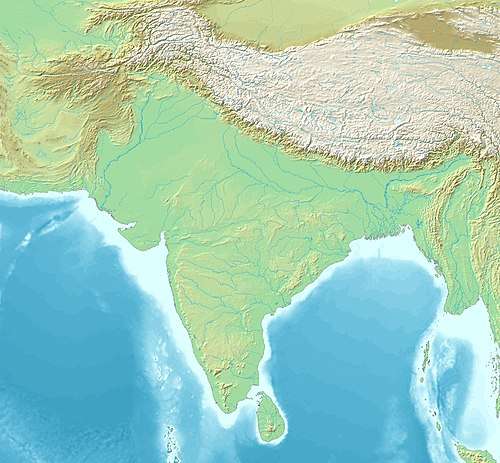Aramaic Inscription of Laghman
The Aramaic inscription of Laghman, also called the Laghman I inscription to differentiate from the Laghman II inscription discovered later, is an inscription on a slab of natural rock in the area of Laghmân, Afghanistan, written in Aramaic by the Indian emperor Ashoka about 260 BCE, and often categorized as one of Minor Rock Edicts of Ashoka.[1][2] This inscription was published in 1970 by André Dupont-Sommer. Since Aramaic was an official language of the Achaemenid Empire, and reverted to being just its vernacular tongue in 320 BCE with the conquests of Alexander the Great, it seems that this inscription was addressed directly to the populations of this ancient empire still present in northwestern India, or to border populations for whom Aramaic remained the language used in everyday life.[3]
| Aramaic inscription of Laghman | |
|---|---|
 Aramaic inscription of Laghman | |
| Material | Natural stone. |
| Writing | Aramaic |
| Created | circa 260 BCE |
| Period/culture | 3rd Century BCE |
| Discovered | 34.5846°N 70.1834°E |
| Place | Laghman Province, Afghanistan |
| Present location | Laghman Province, Afghanistan |


Epigraphical context
The chance discovery by two Belgian anthropologists of this inscription in 1969 is one of a set of similar inscriptions in Aramaic or Greek (or both together), written by Asoka. In 1915, Sir John Marshall had discovered the Aramaic Inscription of Taxila, followed in 1932 by the Pul-i-Darunteh Aramaic inscription. In 1958 the famous Bilingual Kandahar Inscription, written in Greek and Aramaic was discovered, and in 1963 the Greek Edicts of Ashoka, again in Kandahar. In the same year 1963 and again in Kandahar, an inscription in "Indo-Aramaic" known as the Kandahar Aramaic inscription or Kandahar II was found, in which the Indian Prakrit language and the Aramaic language alternate, but using only the Aramaic script. The Aramaic parts translate the Indian parts transcribed in the Aramaic alphabet. A few years after this description was discovered, in 1973, the Lahmann II inscription followed.[4]
The inscription
The text of the Aramaic Inscription of Laghman has been transliterated into the Roman alphabet and translated as follows:[3]
BŠNT 10 | ḤZY | PRYDRŠ MLK' | RQ DḤ'
MH MṢD BRYWT KWRY
MN ŠRYRYN DWDY MH 'BD RYQ QŠTN
200 ZNH TMH TDMR ŠMH ZNH 'RH' KNPTY SHTY
GNT' YTRY 120 TRT' TNH 100 'L' 80
'M W'ŠW DYN'In the year 10, behold, the king Priyadasi expelled vanity from among prosperous men,
friends of that which is vain, friends of those who fish fish creatures.
At 200 "bows", there is over there the place called Tadmor.
This is the KNPTY road, that is to say (the road) of the Garden:
more than 120 ("bow"). At TRT', here: 100. Above: 80.Done with Wasu The Judge
— Translation by André Dupont-Sommer [3]
Interpretations
The translation is slightly incomplete but brings some valuable indications. It first mentions the propagation of moral rules, which Ashoka will call "Dharma" in his Edicts of Ashoka, consisting of the abandonment of vanity and respect for the life of the people and animals (here, urging people to give up fishing).[3][2]

Then, according to semitologist André Dupont-Sommer, who made a detailed analysis of the script observed in multiple rock inscriptions in the Laghman valley as well as in other Aramaic inscriptions of Ashoka,[5] the inscription mentions the city of Tadmor (Tdmr in the Aramaic script in the inscription, ie Palmyra), destination of the great commercial road leading from India to the Mediterranean basin, located at a distance of 3800 km. According to the reading of Dupont-Sommer, Palmyra is separated by two hundreds "bows" from Laghman. In the inscription, the word used to indicate bow is "QŠTN", and Dupont-Sommer asserted that it is an Aramaic word denoting a unit to measure a distance of 15 to 20 kilometres, which could represent a day on the road for an archer.[3] Other distances are then given, which makes it possible to interpret Laghman's inscription as a kind of information terminal on the main trade route with the West.[3][6]
Franz Altheim and Ruth Altheim-Stiehl read three hundred instead of two hundred bows; they equated it with the Vedic unit of measurement yojona, c. 12 kilometres, which would result in a number close to the actual 3800 kilometres distance between Laghman and Palmyra.[7] The linguist Helmut Humbach criticized the reading of Dupont-Sommer and considered his claims regarding the distance to have no validation.[8]
Another issue is that the Aramaic alphabet, the letters "r" and "d" share an identical character.[9] Jean de Menasce read the city's name "Trmd" and identified it with Termez on the Oxus river.[10] Linguist Franz Rosenthal also contested the reading of Dupont-Sommer and considered that the inscription refers to an estate called "Trmr".[11] Historian Bratindra Nath Mukherjee rejected the readings of both Dupont-Sommer and de Menasce; he contested the large value attributed to "bow", considering it a small unit. The historian also rejected the reading of Tdmr and Trmd as referring to a city; in the view of Mukherjee, the name, whether Tdmr or Trmd refers to the rock on which the inscription was carved itself.[10][12]
The Aramaic Inscription of Laghman is the oldest of the known Ashoka inscriptions, with the Kandahar Bilingual Inscription, both dated to the year 10 of Ashoka's reign.[3]
Another Aramaic inscription, the Lahmann II inscription, almost identical, was discovered nearby in the Laghman Valley, and published in 1974.[13]
See also
- List of the Edicts of Ashoka
- Kandahar Bilingual Inscription
- Asoka - the Buddhist Emperor of India Chapter 4 by Vincent Arthur Smith: The Rock Edicts (this version)
Sources
- Kaizer, Ted (2017). "Trajectories of Hellenism at Tadmor-Palmyra and Dura-Europos". In Chrubasik, Boris; King, Daniel (eds.). Hellenism and the Local Communities of the Eastern Mediterranean: 400 BCE-250 CE. Oxford University Press. ISBN 978-0-192-52819-3.CS1 maint: ref=harv (link)
- MacDowall, David w.; Taddei, Maurizio (1978). "The Early Historic Period: Achaemenids and Greeks". In Allchin, Frank Raymond; Hammond, Norman (eds.). The Archaeology of Afghanistan from Earliest Times to the Timurid Period. Academic Press. ISBN 978-0-120-50440-4.CS1 maint: ref=harv (link)
- Mukherjee, Bratindra Nath (2000) [1984]. Studies in Aramaic Edicts of Aśoka (2 ed.). Kolkata: Indian Museum. OCLC 62327000.CS1 maint: ref=harv (link)
- Rosenthal, Franz (1978). "The Second Laghmân Inscription". Eretz-Israel: Archaeological, Historical and Geographical Studies. Israel Exploration Society. 14: H.L. Ginsberg Volume. ISSN 0071-108X.CS1 maint: ref=harv (link)
References
- Nakamura, Hajime (1987). Indian Buddhism: A Survey with Bibliographical Notes. Motilal Banarsidass. p. 349. ISBN 9788120802728.
- Behrendt, Kurt A. (2004). Handbuch der Orientalistik. BRILL. p. 39. ISBN 9004135952.
- A new Aramaic inscription of Asoka found in the Laghman Valley (Afghanistan), André Dupont-Sommer Proceedings of the Academy of Inscriptions and Belles-Lettres Year 1970 114-1 pp.158-173
- History of Discoveries and identifications from M. Boyce / F. Grenet, A History of Zoroastrianism, Zoroastrianism under Macedonian and Roman Rule, 1991.
- Script of the Laghman Valley Fig 3
- The Silk Road Encyclopedia. Seoul Selection. 2016. p. 991. ISBN 9781624120763.
- Kaizer 2017, p. 33, 34.
- MacDowall & Taddei 1978, p. 192.
- Kaizer 2017, p. 34.
- Mukherjee 2000, p. 11.
- Rosenthal 1978, p. 99.
- Kaizer 2017, p. 33,34.
- Essenism and Buddhism, Dupont-Sommer, André, Proceedings of the sessions of the Academy of Inscriptions and Belles-Lettres Year 1980 124-4 pp.698-715 p.707
| Edicts of Ashoka (Ruled 269–232 BCE) | |||||
| Regnal years of Ashoka |
Type of Edict (and location of the inscriptions) |
Geographical location | |||
| Year 8 | End of the Kalinga war and conversion to the "Dharma" |  Udegolam Nittur Brahmagiri Jatinga Rajula Mandagiri Yerragudi Sasaram Barabar Kandahar (Greek and Aramaic) Kandahar Khalsi Ai Khanoum (Greek city) | |||
| Year 10[1] | Minor Rock Edicts | Related events: Visit to the Bodhi tree in Bodh Gaya Construction of the Mahabodhi Temple and Diamond throne in Bodh Gaya Predication throughout India. Dissenssions in the Sangha Third Buddhist Council In Indian language: Sohgaura inscription Erection of the Pillars of Ashoka | |||
| Kandahar Bilingual Rock Inscription (in Greek and Aramaic, Kandahar) | |||||
| Minor Rock Edicts in Aramaic: Laghman Inscription, Taxila inscription | |||||
| Year 11 and later | Minor Rock Edicts (n°1, n°2 and n°3) (Panguraria, Maski, Palkigundu and Gavimath, Bahapur/Srinivaspuri, Bairat, Ahraura, Gujarra, Sasaram, Rajula Mandagiri, Yerragudi, Udegolam, Nittur, Brahmagiri, Siddapur, Jatinga-Rameshwara) | ||||
| Year 12 and later[1] | Barabar Caves inscriptions | Major Rock Edicts | |||
| Minor Pillar Edicts | Major Rock Edicts in Greek: Edicts n°12-13 (Kandahar) Major Rock Edicts in Indian language: Edicts No.1 ~ No.14 (in Kharoshthi script: Shahbazgarhi, Mansehra Edicts (in Brahmi script: Kalsi, Girnar, Sopara, Sannati, Yerragudi, Delhi Edicts) Major Rock Edicts 1-10, 14, Separate Edicts 1&2: (Dhauli, Jaugada) | ||||
| Schism Edict, Queen's Edict (Sarnath Sanchi Allahabad) Lumbini inscription, Nigali Sagar inscription | |||||
| Year 26, 27 and later[1] |
Major Pillar Edicts | ||||
| In Indian language: Major Pillar Edicts No.1 ~ No.7 (Allahabad pillar Delhi pillar Topra Kalan Rampurva Lauria Nandangarh Lauriya-Araraj Amaravati) Derived inscriptions in Aramaic, on rock: | |||||
